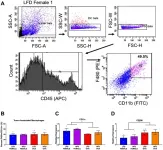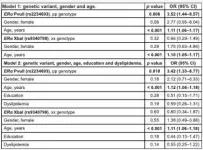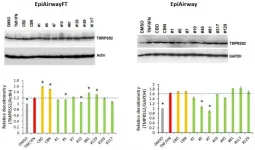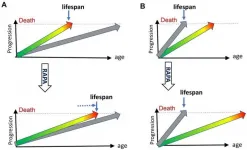(Press-News.org) Oncotarget published "High-fat diet-fed ovariectomized mice are susceptible to accelerated subcutaneous tumor growth potentially through adipose tissue inflammation, local insulin-like growth factor release, and tumor associated macrophages" which reported that the association between obesity and colorectal cancer (CRC) risk has been well established. This relationship appears to be more significant in men than in women, which may be attributable to sex hormones - controlled animal studies to substantiate these claims and the mechanisms involved are lacking. MC38 murine colon adenocarcinoma cells were injected subcutaneously into high-fat diet fed male, female and ovariectomized female C57BL/6 mice.
HFD OVX mice exhibited the most significant tumor growth compared to HFD male and female mice and this was associated with increased subcutaneous adipose tissue.
Further, the subcutaneous adipose tissue depots within HFD OVX mice exhibited more severe macrophage associated inflammation compared to female, but not male mice.
Conditioned media from subcutaneous adipose tissue of HFD OVX contained higher IGF-1 levels compared to male, but not female mice.
Finally, HFD OVX mice had increased M2-like gene expression in their tumor-associated macrophages compared to female mice.
Dr. Angela Murphy from The University of South Carolina said, "There is convincing evidence that excess body weight is associated with increased risk for late onset (> 50 years of age) colorectal cancer (CRC)."
There is convincing evidence that excess body weight is associated with increased risk for late onset (> 50 years of age) colorectal cancer (CRC)
Taken together, the current literature suggests that:
sex disparities are evident in obesity-enhanced CRC, and
hormonal status likely plays a role in CRC risk in women
These perturbations have been associated with CRC risk and are likely biological factors that link obesity to CRC risk.
For instance, the homeostasis model of risk assessment-insulin resistance has been reported to be associated with risk for CRC.
As hormone status is an influential risk factor for both obesity and CRC, the Oncotarget authors also sought to examine the effect of ovarian hormone deficiency on obesity-enhanced CRC.
Overall, this study provides insight into the contributions of hormonal status, fat distribution, and local versus systemic effects of obesity on CRC risk.
The Murphy Research Team concluded in their Oncotarget Research Paper, "our study confirms that established obesity following 20-21 weeks of high-fat-diet feedings enhanced the growth of subcutaneously implanted MC38 tumors, but this appears to be largely due to the increase in tumorigenesis in the OVX mice. We established that diet induced obesity and associated insulin resistance manifest differently in male, female, and OVX mice. Although we were unable to completely replicate epidemiological data, we report that obese OVX mice are most vulnerable to accelerated subcutaneous tumor growth in the MC38 model. Our data suggest several potential mechanisms including increased local adiposity, increased local inflammation and IGF-1, and polarization of macrophages to an M2 phenotype, providing insight into this obesity enhanced tumor growth in OVX mice."
Sign up for free Altmetric alerts about this article
DOI - https://doi.org/10.18632/oncotarget.27832
Full text - https://www.oncotarget.com/article/27832/text/
Correspondence to - Angela Murphy - Angela.Murphy@uscmed.sc.edu
Keywords -
colorectal cancer,
obesity,
metabolism,
macrophage,
inflammation
About Oncotarget
Oncotarget is a weekly, peer-reviewed, open access biomedical journal covering research on all aspects of oncology.
To learn more about Oncotarget, please visit https://www.oncotarget.com or connect with:
SoundCloud - https://soundcloud.com/oncotarget
Facebook - https://www.facebook.com/Oncotarget/
Twitter - https://twitter.com/oncotarget
LinkedIn - https://www.linkedin.com/company/oncotarget
Pinterest - https://www.pinterest.com/oncotarget/
Reddit - https://www.reddit.com/user/Oncotarget/
Oncotarget is published by Impact Journals, LLC please visit http://www.ImpactJournals.com or connect with @ImpactJrnls
Oncotarget recently published "Estrogen receptor α polymorphism is associated with dementia in a Brazilian cohort" which reported that the growth of the elderly population is a worldwide phenomenon and it is associated with chronic diseases, including dementia.
In this scenario, the present study aimed to evaluate a possible association of estrogen receptor α polymorphisms with dementia in a Brazilian cohort.
The genotyping for the ERα PvuII and XbaI polymorphisms were performed by polymerase chain reaction-restriction fragment length polymorphism.
The ERα PvuII pp genotype was associated with a higher odds ratio for dementia (OR = 3.42, 95% CI = 1.33-8.77, p = 0.01, ...
Here is a link to a free Altmetric Report on this Research Output
Aging-US published "Hyperbaric oxygen therapy increases telomere length and decreases immunosenescence in isolated blood cells: a prospective trial" which reported that the aim of the current study was to evaluate whether hyperbaric oxygen therapy (HBOT) affects telomere length (TL) and senescent cell concentrations in a normal, non-pathological, aging adult population.
Thirty-five healthy independently living adults, aged 64 and older, were enrolled to receive 60 daily HBOT exposures.
Whole blood samples were collected at baseline, at the 30th and 60th session, and 1-2 weeks following the last HBOT session.
Telomeres ...
Aging-US published "In search of preventive strategies: novel high-CBD Cannabis sativa extracts modulate ACE2 expression in COVID-19 gateway tissues" which reported that Cannabis sativa, especially those high in the anti-inflammatory cannabinoid cannabidiol, has been found to alter gene expression and inflammation and harbour anti-cancer and anti-inflammatory properties.
Working under a Health Canada research license, the Aging-US authors developed over 800 new C. sativa cultivars and hypothesized that high-CBD C. sativa extracts may be used to down-regulate ...
Aging-US published "DNA- and telomere-damage does not limit lifespan: evidence from rapamycin" which reported that failure of rapamycin to extend lifespan in DNA repair mutant and telomerase-knockout mice, while extending lifespan in normal mice, indicates that neither DNA damage nor telomere shortening limits normal lifespan or causes normal aging.
Dr. Mikhail V. Blagosklonny said, "As a provocative title has recently announced, 'rapamycin fails to extend lifespan in DNA repair -deficient mice' [1]. The word 'fails' implies bad news. Rapamycin tried but failed. Yet, it is expected that the anti-aging ...
East Hanover, NJ. March 8, 2021. Kessler Foundation researchers have demonstrated changes in the functional connectivity within the 'fatigue network' in response to cognitive fatigue. This finding, the first of its kind, was reported in Scientific Reports on December 14, 2020 in the open access article, "Using functional connectivity changes associated with cognitive fatigue to delineate a fatigue network" (doi: 10.1038//s41598-020-78768-3).
The authors are Glenn Wylie, DPhil, Brian Yao, PhD, Helen M. Genova, PhD, Michele H. Chen, PhD, and John DeLuca, PhD, of Kessler Foundation. All have faculty appointments at Rutgers New Jersey Medical School. Dr. Wylie is also a research scientist at The Department of Veterans' Affairs War-related Injury and Illness ...
A new study of the U.K. and South Africa variants of SARS-CoV-2 predicts that current vaccines and certain monoclonal antibodies may be less effective at neutralizing these variants and that the new variants raise the specter that reinfections could be more likely.
The study was published in Nature on March 8, 2021. A preprint of the study was first posted to BioRxiv on January 26, 2021.
David Ho (Credit: Columbia University Irving Medical Center)
The study's predictions are now being borne out with the first reported results of the Novavax vaccine, says the study's lead author David ...
Hamilton, ON (March 8, 2021) - An analysis of several large studies involving participants from more than 60 countries, spearheaded by researchers from McMaster University, has found that eating oily fish regularly can help prevent cardiovascular disease (CVD) in high-risk individuals, such as those who already have heart disease or stroke.
The critical ingredient is omega-3 fatty acids, which researchers found was associated with a lower risk of major CVD events such as heart attacks and strokes by about a sixth in high-risk people who ate two servings of fish rich in omega-3 each week.
"There is a significant protective benefit of fish consumption in people with cardiovascular disease," said lead co-author Andrew Mente, associate ...
Personalised 3D printed models created from cardiac imaging data, mainly from cardiac CT images have been increasingly used in cardiovascular disease, primarily in the preoperative planning and simulation of complex surgical procedures, as well as medical education. 3D printed models are proved to be highly accurate in replicating normal anatomy and cardiac pathology with reported differences less than 0.5 mm between 3D printed models and original sources images. Further to these applications, a new research direction of utilising 3D printed models is to study the optimal CT scanning protocols in cardiovascular disease with the aim of reducing radiation dose while preserving diagnostic image quality. To achieve ...
A new fabrication technique could allow solid-state automotive lithium-ion batteries to adopt nonflammable ceramic electrolytes using the same production processes as in batteries made with conventional liquid electrolytes.
The melt-infiltration technology developed by materials science researchers at the Georgia Institute of Technology uses electrolyte materials that can be infiltrated into porous yet densely packed, thermally stable electrodes.
The one-step process produces high-density composites based on pressure-less, capillary-driven infiltration of a molten solid electrolyte into porous bodies, including multilayered electrode-separator stacks.
"While the melting point of traditional ...
You've heard of animals that can lose and then regenerate a tail or limb. But scientists reporting in the journal Current Biology on March 8 have now discovered two species of sacoglossan sea slug that can do even better, shedding and then regenerating a whole new body complete with the heart and other internal organs. The researchers also suggest that the slugs may use the photosynthetic ability of chloroplasts they incorporate from the algae in their diet to survive long enough for regeneration.
"We were surprised to see the head moving just after autotomy," said Sayaka Mitoh of Nara ...






